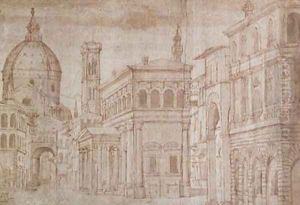Baldassare (Baldassare da Urbino) Lanci Paintings
Baldassare Lanci, also known as Baldassare da Urbino, was an Italian architect, engineer, and painter born in 1510 in Urbino, Italy. He was an important figure in the late Renaissance period, known for his contributions to both military engineering and urban planning. Lanci worked in a period of transition when the ideals of the Renaissance were being applied to many fields, including military architecture and city planning.
Lanci began his career as a painter but gradually became more involved in architecture and engineering. His work was influenced by the prevailing ideas of the Renaissance, particularly the emphasis on symmetry, proportion, and the use of the classical orders in architecture. He was also influenced by the works of Vitruvius, an ancient Roman architect whose treatises on architecture were rediscovered and widely studied during the Renaissance.
As a military engineer, Lanci was involved in the design and construction of fortifications. He worked for various Italian states that were often at war with each other or with foreign powers, and his skills were in high demand. Lanci's approach to fortification reflected the changing nature of warfare at the time, with the advent of gunpowder and artillery necessitating new forms of defensive structures. He is credited with developing a system of bastioned fortifications, which were star-shaped structures designed to withstand cannon fire and provide defenders with the ability to deliver flanking fire against attackers.
Apart from his military work, Lanci is also remembered for his urban planning projects. He was engaged by Cosimo I de' Medici, the Grand Duke of Tuscany, to work on the urban renewal of various Tuscan cities. His plans often included the regularization of streets, the creation of public squares, and the designing of new civic buildings that were in harmony with the existing urban fabric.
Baldassare Lanci's influence extended beyond his immediate projects. His ideas and designs were studied and emulated by subsequent generations of architects and engineers. Despite his considerable contributions, Lanci's fame has been somewhat overshadowed by more well-known contemporaries such as Michelangelo and Leonardo da Vinci.
Lanci died in 1571, leaving behind a legacy that reflected the innovative and interdisciplinary spirit of the Renaissance. His work remains a testament to the integration of art, science, and practical engineering that characterized the period.
